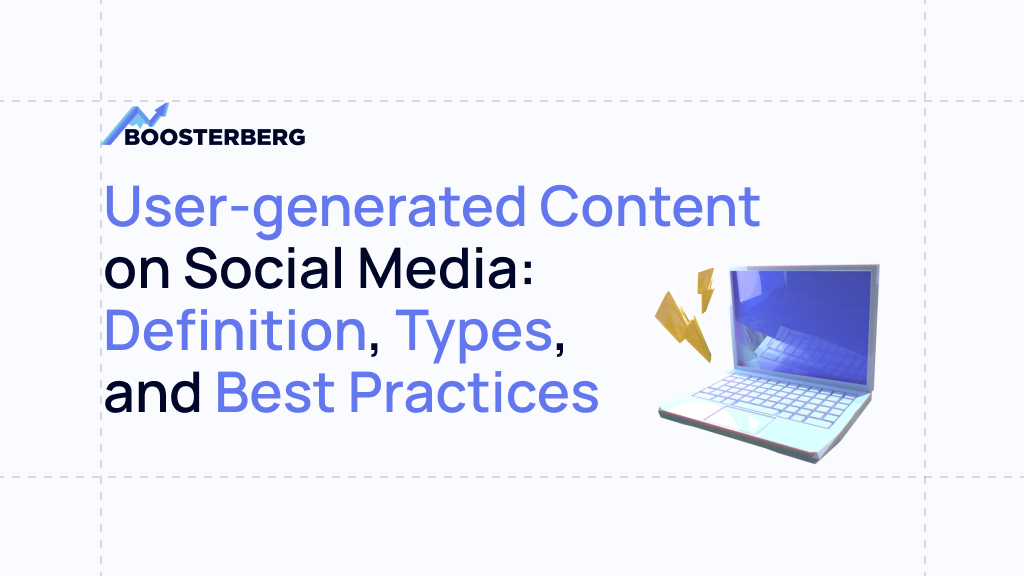People don’t like ads. There, we said it. In an environment where people are willing to pay a subscription fee to watch TV without commercials, the marketing industry must find new ways to reach consumers.
Before, it was enough if a company invested in a few paid ad campaigns and PR articles. Today, people are better educated and demand more information before purchasing. They will sooner listen to what other people have to say about the product they’re about to buy rather than believing marketing materials.
According to a study by Stackla conducted in 2019, only 15% of consumers prefer brand-created visuals over user-generated content. Fortunately for customers, we live in the age of user-generated content, or UGC, which is a powerful marketing tool.
This article will examine what it is and how it fits into your marketing funnel. Let’s dive in!
What is UGC?
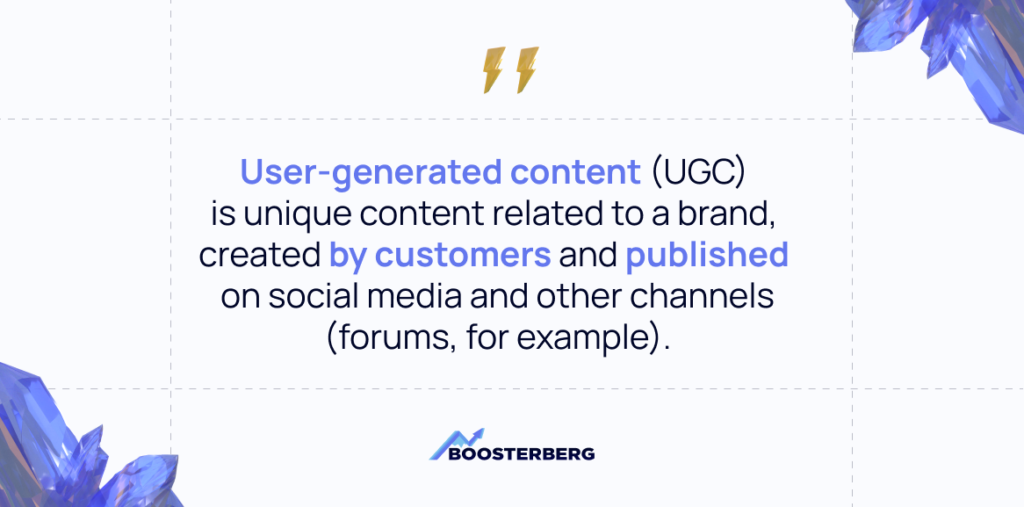
User-generated content (UGC) is unique content related to a brand, created by customers and published on social media and other channels (forums, for example).
It comes in many shapes:
- Videos
- Images
- Reviews
- Testimonials and recommendations
- Podcasts
- Product review blogs
- Live streams
- Social media content (posts on FB or IG, Tweets, Linkedin Posts)
- Hashtags
- Q&A
In e-commerce marketing, UGC is highly effective at converting customers. It is basically word of mouth – the most powerful persuasion tool. Here are some statistics about user-generated content you might find of interest.
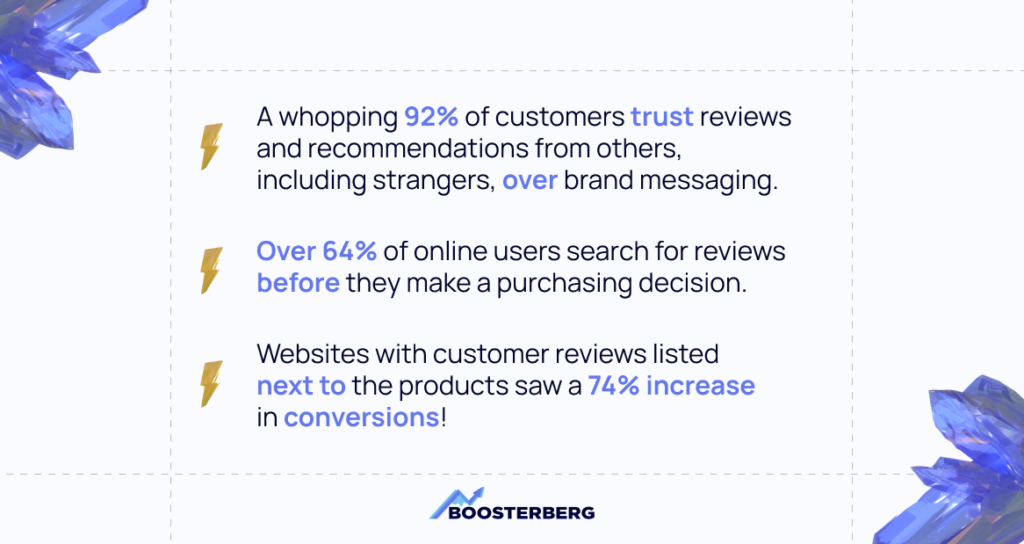
- A whopping 92% of customers trust reviews and recommendations from others, including strangers, over brand messaging.
- Over 64% of online users search for reviews before they make a purchasing decision.
- Websites with customer reviews listed next to the products saw a 74% increase in conversions!
Users can generate different content, including reviews, but not only reviews. You’ve probably seen other types of UGC without even realizing they exist.
Here are two examples of the most common social media content generated by users.
Example no. 1
A new video game came out just last week. You’re considering buying it, but it’s pretty expensive, and what if it’s not worth the money? So you start searching for reviews from other people who have already tried the game. You can also find gameplay videos and walkthroughs on Youtube, allowing you to see how the game looks before you buy it.
Example no. 2
Your Instagram feed shows you a pair of nice shoes by a local designer. You are interested in buying them, but the designer’s Instagram feed and website only showcase highly styled, edited photos, and you are concerned the shoes won’t look as good in person. As you recheck the designer’s profile, you click on the feed that lets you view images where customers have tagged them.
Having entered a completely different feed, you can see how the shoes look on people, worn and used in real life, not just for photos.
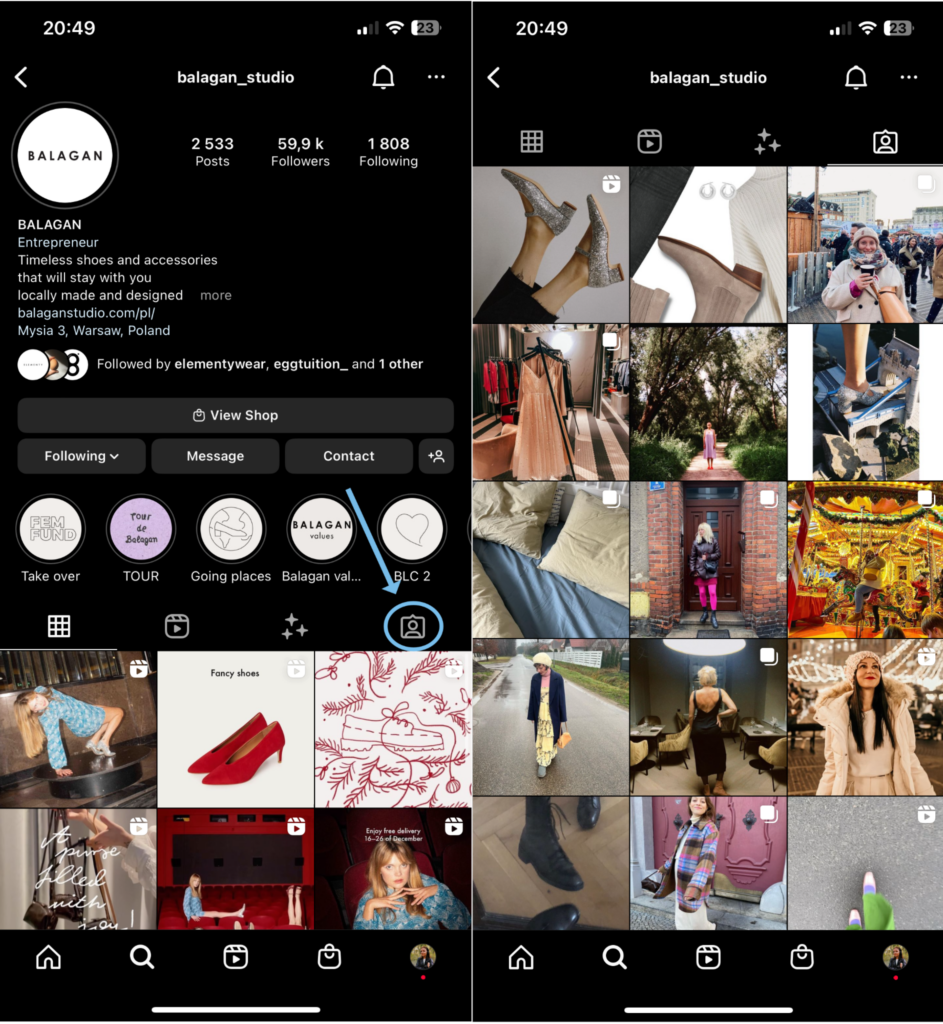
This is user-generated content.
USER-GENERATED CONTENT VS. INFLUENCER MARKETING
It is important to distinguish between user-generated content and influencer marketing. The two may sometimes overlap since influencers are usually also users, but they are paid to create that content, while users create it for free.
According to SEMRush:
In marketing, user-generated content (or UGC) often refers to social posts mentioning and/or endorsing a product that individuals create and share without being paid.
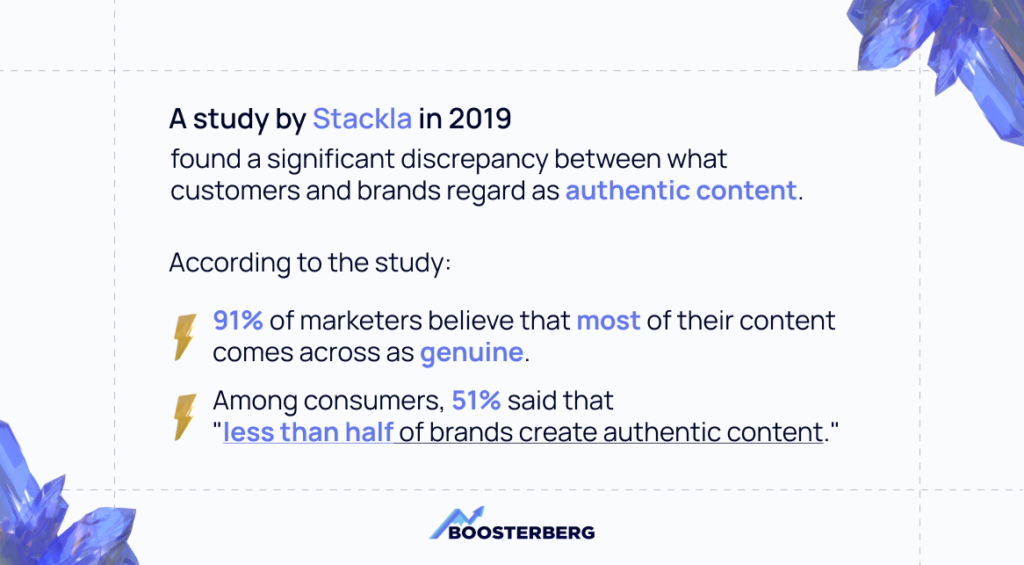
A study by Stackla in 2019 found a significant discrepancy between what customers and brands regard as authentic content. According to the study, 91% of marketers believe that most of their content comes across as genuine. Among consumers, 51% said that “less than half of brands create authentic content.”
This study only proved that marketers underestimate the power of user-generated content. The question arises: how do we achieve authenticity in marketing without letting users control the process?
There is constant pressure on marketers to produce more content in an environment where it’s challenging to stand out. With ever-changing social media algorithms thrown into the mix, marketers are constantly adapting and rediscovering more effective paths for reaching consumers.
It’s hard to argue with the numbers. People prefer real, raw information, unprocessed and unpolished. What if your followers respond better to content created by other users than by your marketing team? Instead of focusing on what doesn’t work, why don’t you direct some of your efforts to UGC?
UGC IS OMNICHANNEL
The advantage of using UGC is that it works at every stage of your marketing funnel. Content that falls under this category isn’t that common, so applying it to your marketing strategy is a no-brainer.
User-generated content gets 28% more engagement on social media channels than standard brand posts. So, if you encourage people to create content for you, you will increase your engagement rate and improve your TOFU (Top of the Funnel) strategy.
You can also use UGC to improve your MOFU (Middle of the Funnel) strategy. According to Digital Information World, websites displaying user content saw a 20% increase in return visitors. Hubspot writes that websites using UGC also experienced an increase in time spent on-site by 90%.
UGC will also boost your conversions and make your BOFU (Bottom of the Funnel) strategy more effective.
Approximately 70% of consumers read reviews or ratings from UGC before making a purchase. About 41% of consumers read four to seven user reviews before purchasing a product. E-commerce websites that don’t allow customers to share positive reviews of their products or photos are losing out on conversions.
WHY IS UGC SO EFFECTIVE: A FEW PSYCHOLOGY LESSONS
As a result of growing up with TV ads, we have become familiar with being disappointed with the products we purchase based on ads. The perfectly round, spotless Big Mac with crunchy lettuce and juicy tomatoes you saw on TV was not the same as the Big Mac you got served at your local McDonald’s. A bowl of cereal does not transform you into a superhero after breakfast. A flashy washing detergent doesn’t remove grass stains from your favorite shirt. We could carry on.
Over and over again, we’ve been fooled, and we’re not about to fall for it again. At least most of us aren’t.
The main point to remember when it comes to UGC is that people trust other people. Also, a couple of other aspects can help you understand why it shouldn’t be underestimated and how to approach it.
Here are three reasons why online users and customers are attracted to user-generated content.
BEING A PART OF THE COMMUNITY
Humans are not solitary creatures. Throughout history, humans have formed groups to survive, and this instinct has remained with us even now, when we are rarely alone. We want to feel like we belong, that we matter, and that we have a voice.
Psychologists McMillan and Chavis developed one of the most popular theories about the Sense of Community in 1986. They proposed that this feeling of belonging was comprised of four aspects:
- Membership
- Influence
- Integration and fulfillment of needs
- Shared emotional connection
McMillan and Chavis suggest that to feel like part of a community, a person must have some level of influence within that community. Accordingly, user-generated content gives people a say in how brands present themselves, and since this makes them feel like they have some level of influence over the brand, they are more likely to contribute.
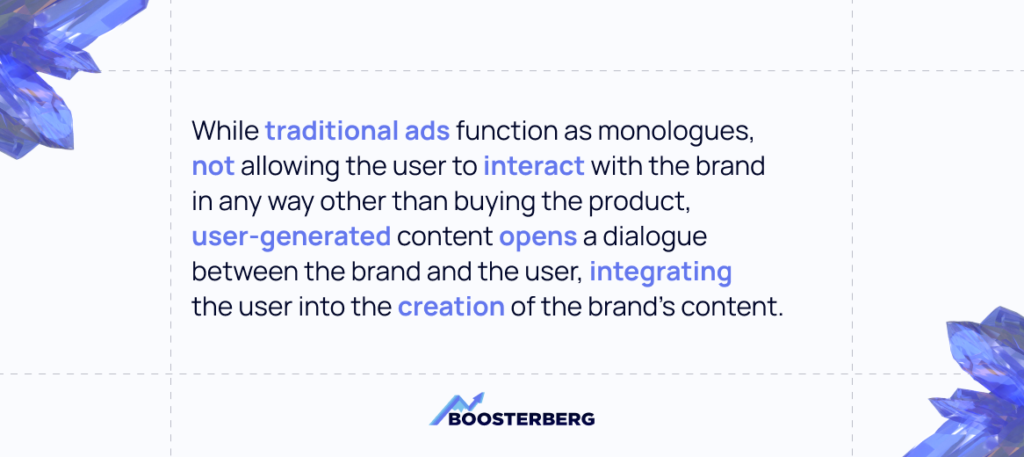
While traditional ads function as monologues, not allowing the user to interact with the brand in any way other than buying the product, user-generated content opens a dialogue between the brand and the user, integrating the user into the creation of the brand’s content.
According to McMillan and Chavis, the fourth element, the shared emotional connection, addresses the impact of humiliation and honor on community members:
Someone who has been rewarded in front of a community feels more attracted to that community, and, if humiliated, feels less attracted.
This is the ideal model for any UGC social media campaign. Your followers should be encouraged to create content related to your brand, and you should reward them with a share on your feed if they do.
This is the ideal model for any UGC social media campaign. Your followers should be encouraged to create content related to your brand, and you should reward them with a share on your feed if they do.
For example,
Milos Nedeljkov, known on Instagram as @balkandad, creates engaging videos about his Balkan heritage. Milos is originally from Serbia, but he currently lives in the USA. His videos reflect his expats’ relationship to their former homelands and cultural stereotypes connected to the Balkans.
His Balkan Dad alter-ego gained him 270K followers who now share his posts and contribute to his profile, try out his recipes, and share them.
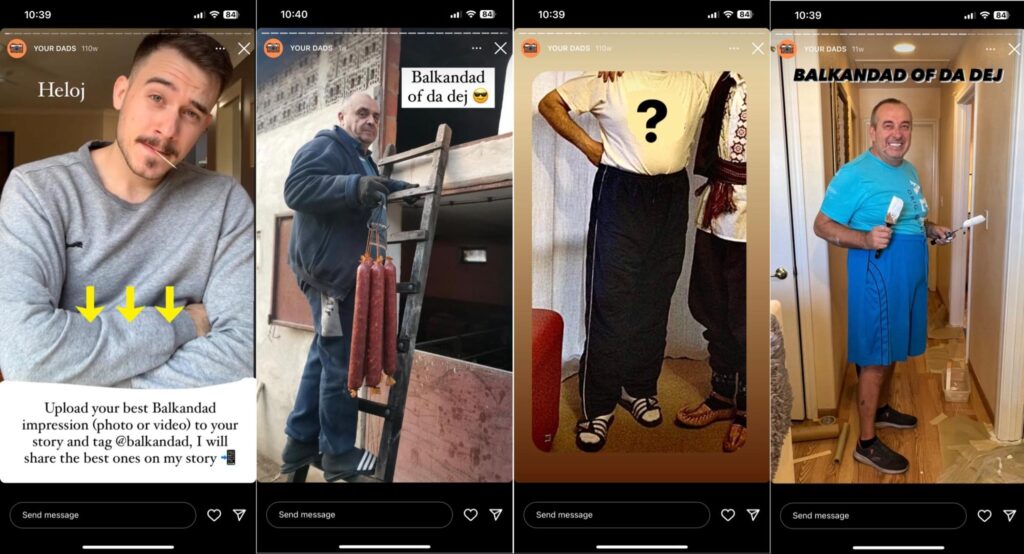
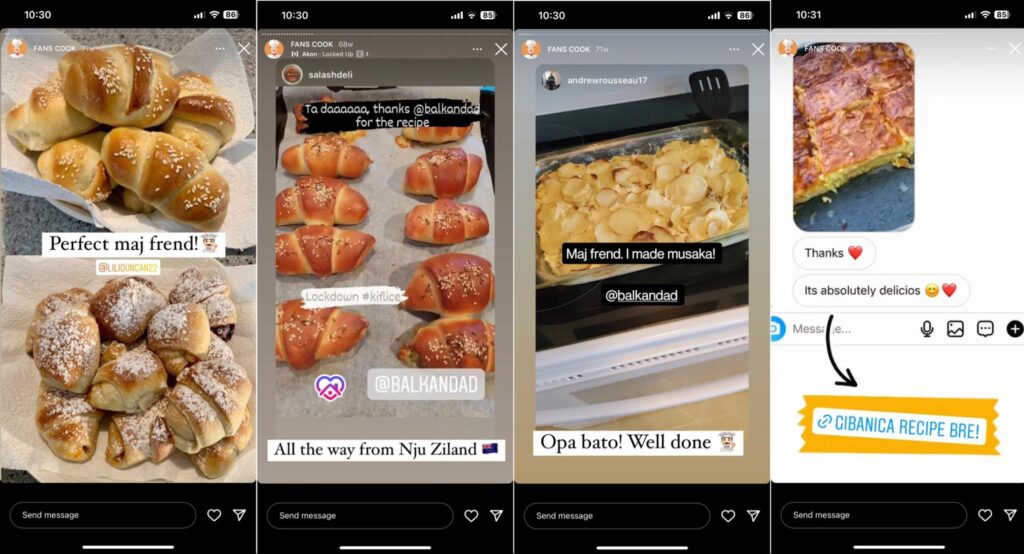
What makes this work? What motivates people to create content for his profile?
As humans, we like being part of a community and contributing. And in this case, since Balkan Dad shares their content, people who are originally from the Balkan countries feel a part of this community again, even if they live abroad.
By sharing their content, Balkan Dad places their followers at the forefront, enhancing their importance in the marketing efforts of his profile. And also, since users are creating the content, it is genuine and authentic, making more people interested in his profile.
TRUST
Consumers create UGC of their own volition. They’re not compensated or reimbursed in any way for it, so other potential customers are more likely to trust it than other forms of marketing.
- The State of UGC report by Tintup for 2021 found that “93% of marketers agree that consumers trust content created by customers more than content created by brands.”
- According to a Nosto report, customers are 9.8x more likely to make a purchase based on user-generated content than influencer content.
In 2021, a TikTok User, Trinidad Sandoval, posted a video in which she shared one of her favorite skincare products and demonstrated its effectiveness.
This is the video:
Trinidad didn’t mention the product by name; she showed it briefly in the video. She didn’t say much about it, but the video became viral, and the product was soon sold out online.
Her video received more than 4 million likes and more than 24 million views in 6 days. Her TikTok profile was relatively new, and she didn’t have many followers at the time. Still, people rushed to the comment section to learn more about this magical product.
This proves the fact that no amount of perfect product pictures and product descriptions on your website will do you more good than a simple, positive testimonial from a happy client. Do not underestimate the power of testimonials.
If you have a product that works, find a way for your users to show it online and encourage them to share it with their friends.
COST-EFFECTIVE WAY TO GENERATE CONTENT AND IDEAS
Free advertising is the most effective advertising. The beauty of user-generated content is that it’s created for free by users, so real marketers don’t have to invest any resources.
Okay, that might be oversimplifying it. To reach the point where people are happy to create content for you, you need to build yourself up, raise awareness, and cement your position. This takes time and money. But once you’re there, using UGC for marketing is cost-effective since you aren’t producing the content or running any ads.
Furthermore, by encouraging your followers to create content for you, you not only save money on ads but also save time. Your followers’ posts, whether they are photos, videos, or reviews, will often provide you with content ideas you can use in the future.
Instagram stories, specifically Q&A Instagram stories, are prime examples of this. When you ask your followers a question, and they start sharing their answers, you gain valuable insight into how they think and get valuable content for resharing on your channel. A post or article idea may come from those answers. Your next ad campaign might be inspired by what you learn.
Let’s see how it works in real life.
Carly Rowena is a fitness instructor based in Britain and the creator of the Moodment app. She shares everything from fitness and workout tips to mental health and wellness content on her Instagram account. Several months ago, she began a regular Q&A section in which people anonymously reveal their deepest secrets.
By sharing her followers’ answers on her profile, she helps others feel less alone in their worries and concerns about life.
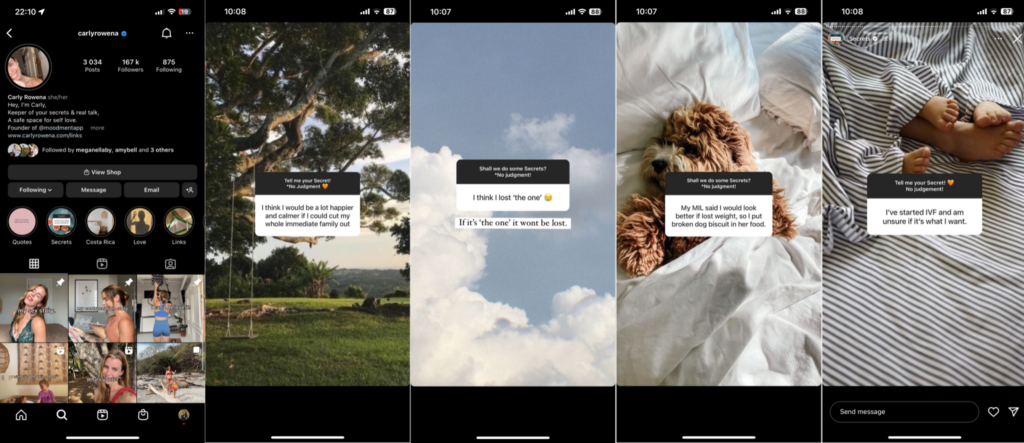
Although this is not the type of content that would create sales, it might convince people to stay on her profile or follow her. This could eventually lead to conversions. In this case, her user-generated content confirms her status as mindfulness and mental health expert, raising brand awareness and solidifying brand recognition.
Using Q&A this way could inspire brands to write blog posts or make videos, which can help them reach new audiences on different platforms.
DO NOT UNDERESTIMATE THE POWER OF UGC AND RESPECT YOUR CUSTOMERS
We have discussed a few examples of how UGC could look and how it can be used to improve your marketing strategy and connect with customers. It’s an endless field of content waiting to be picked. The only thing you need to do is decide when and where it should be distributed.
The next installment of our series will discuss encouraging your customers to create content related to your business and how to utilize that content to your advantage. Remember, however, that if you want to use content from someone else, you must get their permission first. Don’t use their content if you aren’t sure whether they would be OK with it. Ask them and wait for their response. Having good content can be tempting, but you don’t want to risk ruining your relationship with your customers.
